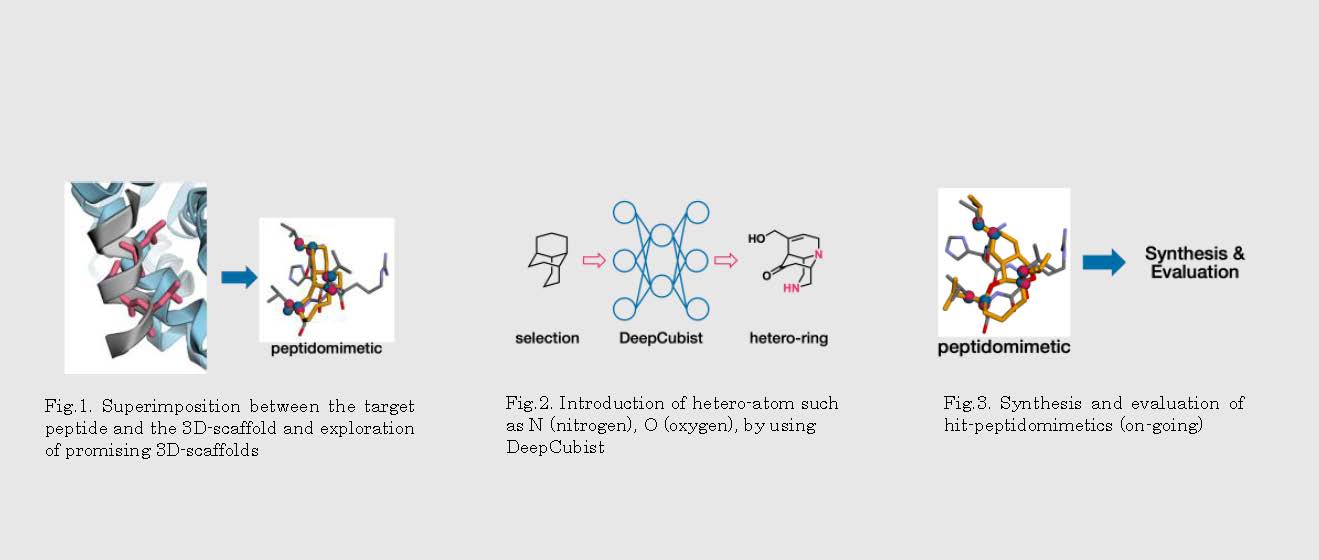
CLS
Laboratory for Chemistry and Life Science, Institute of Integrated Research, Institute of Science Tokyo
東京科学大学
総合研究院
化学生命科学研究所

LAST UPDATE 2025/05/23
-
研究者氏名
Researcher Name垣内亮 Ryo KAKIUCHI
助教 Assistant Professor -
所属
Affiliation東京科学大学 総合研究院 化学生命科学研究所
分子創成化学領域
Laboratory for Chemistry and Life Science, Institute of Integrated Research, Institute of Science Tokyo
Molecular synthesis -
研究キーワード
Research Keywords有機合成化学/創薬化学/ケミカルバイオロジー
Synthetic organic chemistry / Organic chemistry / Chemical biology
- 研究テーマ
Research Subject -
三次元骨格を基盤としたペプチド模倣分子(PPI阻害剤)の開発
Development of peptidomimetics (PPIs-inhibotors) based on 3D-scaffolds
研究の背景 Background of the Research
PPI (タンパク質間相互作⽤)は、⽣体内のタンパク質分⼦間に起こる相互作⽤の総称であり、多くのタンパク質は PPI によって、構造変化が誘発されて機能を発現する。細胞増殖、分化、アポトーシスなどの細胞内シグナル伝達が、PPI によって緻密に制御されている⼀⽅で、がん、神経変性疾患、⽣活習慣病などを惹起する PPI も報告されており、PPI阻害剤の開発は有効な創薬戦略として考えられている。
PPI (protein-protein interaction) is a general term for interactions that occur between protein molecules in a living organism, and many proteins express their functions by inducing conformational changes. Intracellular signal transduction such as cell proliferation, differentiation, and apoptosis are precisely regulated by PPIs, and PPIs that induce cancer, neurodegenerative diseases, and lifestyle-related diseases have also been reported.
研究の目標 Research Objective
本研究では、いくつかのPPI が α-ヘリックスを介して相互作用していることに着目し、PPI阻害剤として、α-ヘリックスを模倣した「ペプチド模倣分⼦」を創成することを目的とする (Fig. 1.) 。上記の目的を達成すべく、3万近くにもおよぶ籠状の炭素骨格ライブラリーから、模倣するのに最適な骨格を探索するとともに、所属研究室にて開発された’DeepCubist’と呼ばれる機械学習済みのPythonライブラリーを活用することによって、炭素骨格に窒素や酸素などのヘテロ原子を導入したdrug-likenessな三次元骨格を設計する(Fig. 2.)。設計したものの中から、標的PPIについてのドッキングシミュレーションを実施し、化合物の合成を行った後、合成した化合物について、PPIの阻害活性及び細胞生長阻害活性について評価する。(Fig. 3.)
In this study, we focus on the fact that several PPIs interact with each other via α-helices, and aim to create “peptidomimetic molecules” that mimic α-helices as PPI inhibitors (Fig.1). In order to achieve the above goal, we searched for the best skeleton to mimic from a library of nearly 30,000 caged carbon skeletons, and also developed a machine-learned Python library called ‘DeepCubist’ in our lab. a machine-learned Python library called ‘DeepCubist’ developed in our laboratory, to design drug-like three-dimensional skeletons by introducing heteroatoms such as nitrogen and oxygen into the carbon skeleton (Fig.2). From the designed ones, docking simulations will be performed for the target PPI, compounds will be synthesized, and the synthesized compounds will be evaluated for their PPI inhibitory activity and cell growth inhibitory activity (Fig.3).
研究図Figures

論文発表 / Publications
研究者連絡先 / HP
- kakiuchi.r.8e5e
 m.isct.ac.jp
m.isct.ac.jp - https://syn.res.titech.ac.jp/